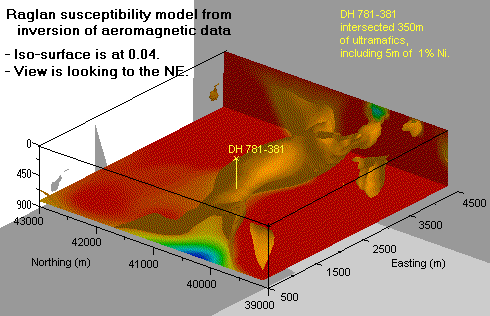
 |
3D Inversion of Magnetics at the Raglan Deposit
|
|
Recall that our objective function constructs smooth models, so discrete geological boundaries may appear as gradational changes, unless a particular value is used in the image, as in the iso-surface renderings. One disadvantage of the cross-sections is that it is sometimes difficult to get a sense of 3D structure. This is where 3D volume rendered images have an advantage. But care must be taken since a different threshold for volume rendering will generate a different image. The next figure illustrates a volume rendering for which a susceptibility value of 0.04 was chosen to render the iso-surface. 
The inversion basically recovered a single elongated magnetic body whose ends coincided with the known outcropping. It was an isosurface image like this one that persuaded the project geologist to spot a deep 1100 metre hole, which confirmed the inversion results that the apparently isolated outcrops on the so-called "5-8 ultramafic flow" and the "Katinniq flow" to the west were in fact connected at depth. The targeted magnetic source was intersected at 650 metres. As a bonus they intersected a 5 metre thick mineralized section (sub-ore grade, approximately 1% nickel) within the 350 metre thick intersection of magnetic ultramafics. The image supplied by Falconbridge is provided by this link (reduced to 800 x 429 pixels, or 46 kbytes).
|